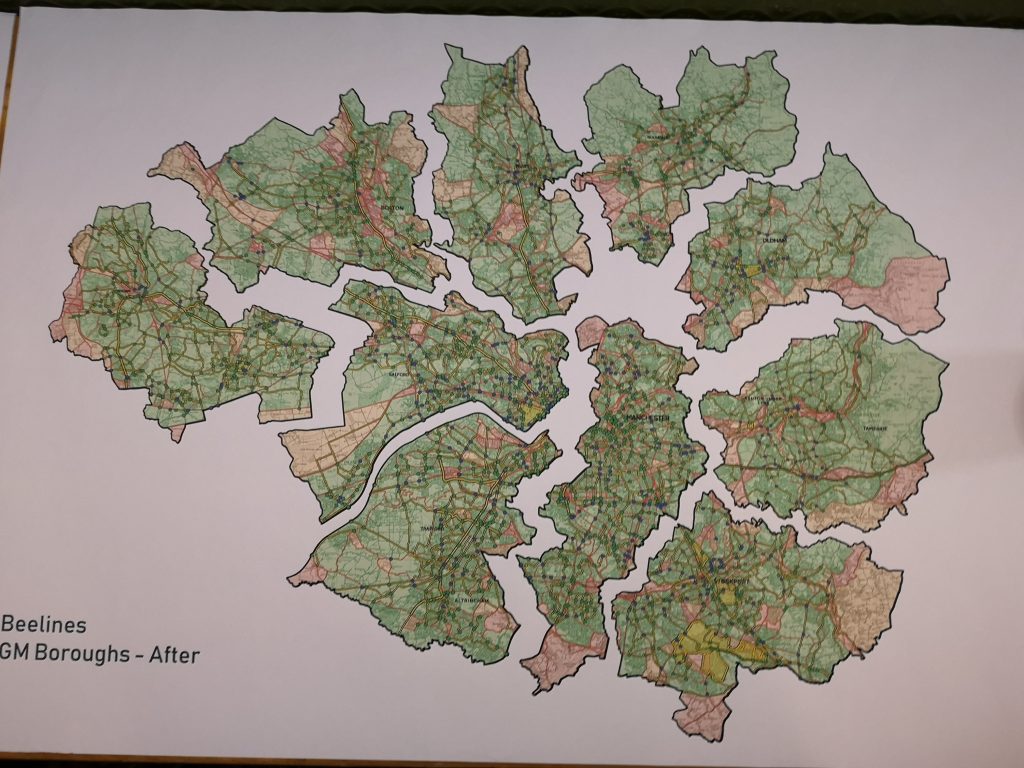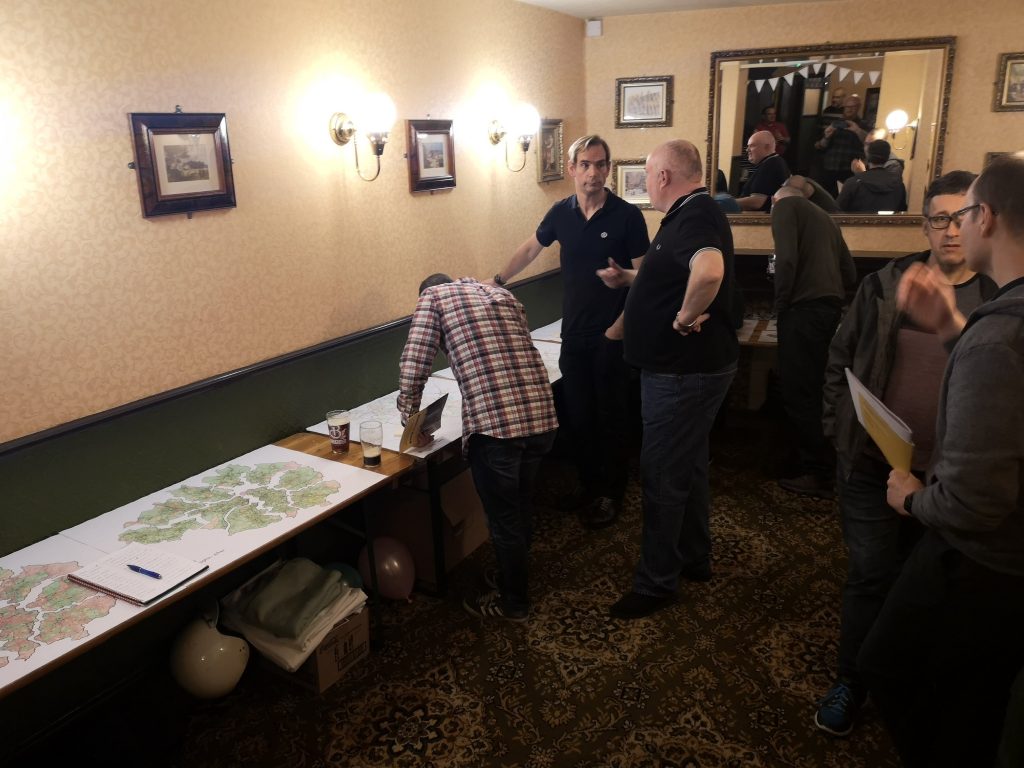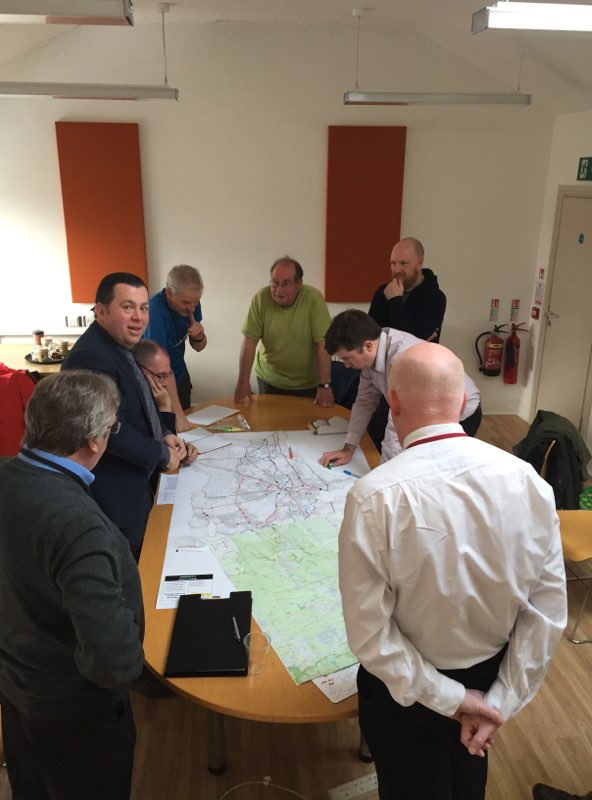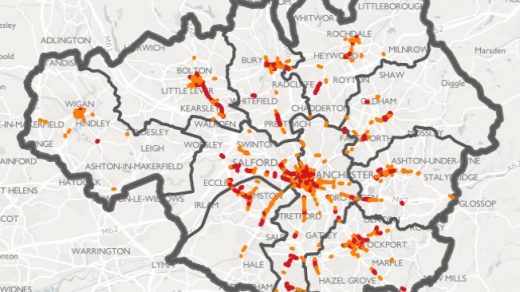Background
Beelines is arguably the most important local transport initiative I will experience in my lifetime. A plan to create a network of a thousand miles of safe routes across the Greater Manchester city-region to enable increased levels of walking and cycling (“active travel”), revolutionise the way we get about the place and mitigate some of the detrimental impacts of car-centric transport planning (congestion, pollution, potholes, poor public health, etc.).
In cycling-advocacy circles, talk has been of little else since the Beelines launch in June 2018. Among people who cycle but don’t actively campaign, most have at least an awareness that Beelines is a thing, though their detailed appreciation of what it entails varies. Outside circles of people who already engage in or take an interest in active travel, I have often encountered blank looks when I say something like, “well, we urgently need Beelines to help reduce motor-traffic levels” or similar. In short, with the exception of those who specifically seek out news on active travel, or know people who do, the message hasn’t penetrated particularly deeply into the general populace. This obviously needs to be rectified.
So let’s go out there and talk to people
I made some inquiries: I asked the Beelines team what, if any, measures they were planning to get the message out there to the public at large. They told me they would be setting up sessions with councils to firm up the initial plans drawn up in the initial planning sessions (documented here for Bury/Tameside, Rochdale & Salford), but did not have any public workshops planned. So then I asked my councillor, Tim Pickstone, whether Bury Council had any public events in the pipeline. He said he wasn’t aware of any but should we arrange one? Of course we should!
So we set about convening a public meeting in Prestwich. The landlord of the Church Inn kindly let us use one of the function rooms, and we promoted the event via social media and through physical flyering.

Proposed Beelines in GM boroughs as currently imagined.
The meeting
On the night my co-host Tom printed out large-format versions of the Beelines maps of the Borough of Bury, we procured felt-tips for people to annotate the maps and I obtained a stack of Chris Boardman’s original Made to Move report – the evidence base for the Beelines vision – for everyone to take away and read up on the issues we wanted to discuss. 18 people had pre-registered via EventBrite, and in the end we had around 30 people crammed into the room.
My proposal for the evening’s format was to give a, say, ten-minute introduction to the broad principles of Beelines and for the group to then adjourn to the maps for detailed consideration of the proposed Beelines routes. However, things turned out a little differently: I ended up fielding questions from the floor for around an hour and a quarter which, being neither a councillor, Council officer nor TfGM/Beelines representative, I did my best to answer.
This demonstrated to me that there’s a tremendous thirst for knowledge around Beelines, there’s a tremendous desire to engage, and it’s actually really quite easy to generate consensus around creating conditions where more people can choose active travel for more journeys. The points I was keen to get across are as follows:
- It is undeniable that levels of vehicle traffic are unsustainable and we urgently need to find ways to reduce congestion across our towns and cities.
- It is undeniable that levels of air pollution are unsustainable and we urgently need to find ways to reduce pollution across our towns and cities.
- It is undeniable that we face an inactivity crisis which is due in no small measure to our over-reliance on motor vehicles and the associated difficulties of integrating active travel into our daily routines.
- It is undeniable that, historically, provision for active travel has taken a back seat to provision for motorised travel, and if we are to address the above issues, then we need to rebalance the urban environment to make active travel more attractive and more viable for more people.
- It is also undeniable that, in order to create a better environment for active travel, you have to make walking and cycling feel safe and appealing, which requires interventions such as (enforced) speed restrictions; filtered permeability (e.g. bollarding roads to permit cycles/pedestrians through but limiting vehicle flow); protected cycle lanes on busy routes; motor-traffic calming/reduction on quieter routes; action on pavement parking to enhance pedestrian comfort; safer crossings to make busy roads easier to traverse for people walking/cycling.
- The cycling aspect of Beelines isn’t aimed at people who already cycle. If we want levels to stay the same, we need to do nothing. If we want to create an environment that feels safe for those who don’t currently ride, we need to make some bold interventions.
- None of this means banning cars or stopping people from driving; it instead means that engaging in active travel will not require an act of bravery. Lower motor-traffic levels will also benefit those who need or simply still want to drive.
- This is all based on sound evidence and research. If anyone disagrees that this approach is the right one to take to facilitate cleaner air, less congestion, fewer potholes, a healthier, happier populace and an overall more pleasant place to live, what is their alternative? In Prestwich, at least, when that question was asked, no one had a counterproposal.
- Lack of money is no longer an excuse for Council inaction. There is currently £160 million waiting to be spent on projects proposed by boroughs that meet the exacting Beelines standards. We obviously would like to see Bury get its fair share of this.
Overall, I felt that there was broad consensus in the room, and people were very keen to discuss wide-ranging issues, such as: what design standards will be applied (these will be of the highest quality and are being drawn up as we speak); the need for continuous footways/cycleways (priority for pedestrians/bike-riders at side roads); the potential political difficulties of re-modelling Prestwich High Street with protected cycle lanes given the disruption caused over the course of the recent works to implement the current design that achieves less for active travel than it should; the fact that, with the cycling aspect, we should also talk about cycles in general, including electrically assisted cycles, as opposed to simply bicycles; and whether Beelines should also work with Sustrans and integrate e.g. Route 6 into the Beelines network (mentioning the issues here does not necessarily mean I agree with them).

There were also a couple of people in the room who were avowedly anti-cyclist, so we also discussed (and dismantled) points about rife red-light running, mandatory insurance for bike-riders, pavement cycling etc. Whilst it was quite exhausting dealing with a tirade of anti-cyclist prejudice (and emotions in the room did get a little frayed by the end), I found it important that people with those kind of views attended, that they had taken themselves out of their echo chamber and spent two hours listening to people with different experiences making points about active travel that I could tell they had never previously considered. And even if they may not have admitted it on the night, they will have gone away with a slightly different perspective on what is being proposed. If this is going to work, then we need to get as many people on board as possible and get the point across that more active travel benefits everyone, whether they’re minded to drive less or not. “Imagine the difference to your car journey if we could get even 10% of the cars in the traffic jam in front of you off the road”. Again, there’s not much even the most avid petrolhead can respond to that.
Bury Council
On the same night, Bury Council were holding a meeting at the Town Hall to which they had invited councillors, TfGM Cycling, various officers and a small number of selected stakeholders (mainly people who cycle in the Borough) in order to firm up their own position on the Beelines network map (which closes for consultation today 30 September 2018) (for a summary from active travel advocate MCRBikeCommuter, who attended, see the text box below).
I heard from a couple of sources that Bury Council were not happy about us holding a “rival” meeting on the same night. What I would say to them is this: we got 30 people to come out on a Thursday night and talk about local transport policy. We started a conversation about Beelines and sought to establish a consensus around the vision to boost active travel in Prestwich, Bury and Greater Manchester. If and when Bury Council rolls out its Beelines plans, wouldn’t they rather have a support base in place? That was a primary aim of the night: start a conversation and get people on side, and I think we achieved that – and in doing so we’re helping the Council do its job. You are welcome.
Account of Bury’s Beelines meeting, held in parallel to ours (courtesy of MCRBikeCommuter)
The Bury Beelines Consultation was presented by Andy Howard from the Walking and Cycling Team and TfGM and facilitated by Chris Wilkinson from Bury Council who is currently holding the reins on this project for the Council. In attendance were two councillors from the south of the Borough, two cyclists from the north of the Borough, the Council’s Rights Of Way Officer and the Council’s Air Quality Officer.
The draft maps were presented for final amendments. The big key message fed back from the attendees was that certain areas particularly around township centres and key employment sites both existing and planned needed a finer grained approach to ensure safe, direct routes to them and permeability through them. It was also highlighted that linked to this was certain townships like Radcliffe had no representative at the meeting to amend the map. The online consultation finishes at the end of this month with the final draft maps hopefully before Xmas.
Andy from TfGM reiterated the policy that routes/crossings needed to be safe, direct and of a high standard to obtain funding. The meeting was more focused than the initial one with everyone now better understanding what Beelines wants to achieve and how they intend to achieve it. As always the devil will be in the detail.

Bury Council fine-tuning its maps at its own meeting.
Conclusion
Forgive the pun, but we’re at a crossroads with transport policy in Greater Manchester. In Beelines we have a phenomenal opportunity to become a city-region that drags itself out of the vehicular fug of the 20th century and becomes a sustainable, pleasant place to live that is fit for the 21st century. It’s still early days in the Beelines process, and councils across Greater Manchester are reacting at different speeds. Salford and Manchester at least have held official public consultations on the plans. Bury inadvertently got both a high-level fine-tune of the “official” map and a public workshop/feedback session – albeit the latter was a citizens’ rather than a Council initiative. And that’s where I see the success of this coming from: given the limited resources available to councils and TfGM/the Beelines team, and in the absence of an effective mass-membership cycling campaign with pan-GM reach, at present I see there to be a clear need for citizen involvement to get the ball rolling and get the messaging across.
Let us know what has been happening in your area, or if you feel more needs to be done to spread the word about Beelines, what you think would be a good way of doing so.
The Beelines interactive map (which closes for comments on Sunday 30 September) can be viewed here: https://mappinggm.org.uk/beelines/.
General comments on Beelines may be sent to the following address for a week or two after the 30 September deadline for map comments: cyclingwalking@greatermanchester-ca.gov.uk
If you would like to sign up for updates on Prestwich Beelines news, you can do so here.





I wonder if it is time to move beyond the bicycle. I understand the following constituencies might be key users of non standard cycles who need carefully thought out and inclusive cycling strategies. Each of these groups need carefully thought through marketing strategies and very carefully designed infrastructure
The last mile distributors – e cargo trikes from open source distribution hubs – at rail heads – rail takes back light goods from road and becomes a common carrier ( of non standard cycles as well). This could be done like milk floats on timetabled rounds. There could be secure drop off points at local bus stops or in parking places.
Small trades. Many small businesses can be done from e cargo trikes. Why the business expense and hassle of running vans? Range and capacity on e trikes is good!
Young families. 25% of young families in Copenhagen have cargo trikes. Why not everywhere?
The very low use car households . Yes, a cargo trike can do a weekly shop. Cars can then be hired as needed and not owned taking up valuable storage space
Older and disabled people. Cycling is easier than walking. Danish neurophysiotherapists prescribe cargo trikes as a core part of stroke rehabilitation .
Think through tools for conviviality and we might help slow down the arctic melting.
What was the problem again?
I agree with all of this, and it’s an absolutely crucial message that can’t be overstated: when we talking about improving conditions for cyclING (not: cyclISTS), this is what we mean. Inclusive, accessible, and utilitarian as opposed to the media’s favourite bogeyman of the lycra lout.